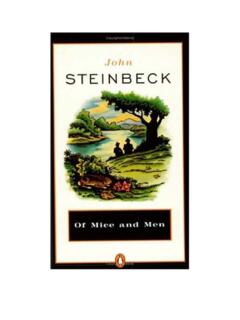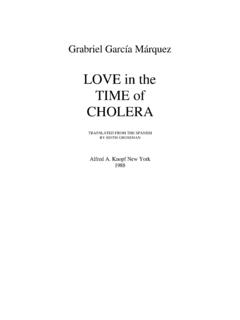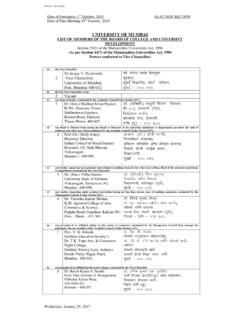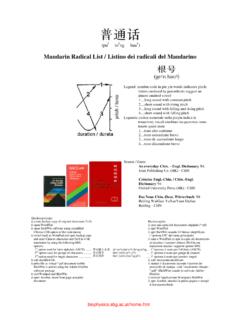Transcription of Cicero Designer: An Environment for End-User Development ...
1 V. Pipek et al. (Eds.): IS-EUD 2009, LNCS 5435, pp. 265 274, 2009. Springer-Verlag Berlin Heidelberg 2009 Cicero designer : An Environment for End-User Development of Multi-Device Museum Guides Giuseppe Ghiani, Fabio Patern , and Lucio Davide Spano ISTI-CNR, HIIS Lab, Via Moruzzi 1, 56124 Pisa, Italy Abstract. This paper describes the design and implementation of a tool to allow people without programming experience to customize the functionality and user interface of a multi-device museum guide. It consists of a direct-manipulation visual Environment that supports editing of the main features of a museum guide and the creation of the associated interactive games. The tool then gener-ates application versions for access through both mobile and large screen sta-tionary devices. We also report on a first empirical evaluation carried out with museum curators. Keywords: End user Development , Multi-Device user Interfaces, Mobile Mu-seum Guides.
2 1 Introduction End-User Development (EUD) [8] has focused mainly on desktop applications. How-ever, mobile technology has penetrated many application domains and mobile devices are more and more powerful in terms of processing and interaction resources. There is an increasing number of applications that aim to exploit such technological offer-ings. Non-professional developers already have difficulties in developing applications for desktop systems, and targeting multi-device environments is too complex, unless they are adequately supported [4]. The prototype described in the paper is an example of a domain specific EUD Environment . The identification of key semantic building blocks and target scenarios guided the creation of an intuitive metaphorical tool to configure context-sensitive museum guides, including educational games and multi-device deployment. In particular, we consider the museum application domain, in which software ap-plications are increasingly used to assist visitors in accessing the relevant information.
3 In addition, museums are dynamic entities and often change the items on exhibit or their locations. Thus, it is important to allow their curators, who presumably have no programming experience, to be able to (re)configure the mobile guide, its content and interactive behaviour. Our work aims to allow museum curators to easily create and modify guides acces-sible through both mobile and large screen stationary devices, providing a rich set of 266 G. Ghiani, F. Patern , and Spano interactions with the museum information, including some interactive games, which can be useful to improve and assess the learning experience. 2 Related Work A visual strategy for developing context-aware applications was proposed in [7]. Such a system, called iCAP, allows end-users to design application prototypes by defining elements (objects, activities) and rules (associations between actions and situations).
4 The rules are graphically edited through basic operations like dragging the defined elements onto rule sheets. Another framework to support people without program-ming experience is eBlocks [6]: it facilitates the creation of customized sensor-based systems and the configuration of condition tables. Differently from iCAP and eBlocks, which are not specifically dedicated to end user Development for mobile environments, our investigation is focused on solutions for facilitating the management of content and the associated interactive functionality also on mobile devices (namely, PDAs and smartphones). Akesson et al. [1] present a user -oriented framework to ease the reconfiguration of ubiquitous domestic environments. The support, running on a tablet PC, adopts a different paradigm, based on jigsaws. Carmien and Fisher [5] describe a framework for customizing mobile applications to help people with cognitive disabilities.
5 A graphic editor, intended to be used by the caretakers, facilitates the management of the task-support scripts for helping the dis-abled. The evaluation of the editing Environment , called MAPS-DE, revealed that the caretakers appreciate the possibility of customizing the prompting system for the needs of individuals with specific disabilities. Like MAPS-DE, our Environment also allows the customization of mobile solutions, but it has educational purposes rather than disabled support and it also allows the generation of application versions for stationary systems with large screens. The use of educational games on mobile phones for enhancing scholars visit of ar-chaeological sites is treated in [2] which, however, does not deal with the develop-ment and modification of application content and behaviour. Bellotti et al. [3] propose a framework for developing edutainment applications, such as mobile tourist guides.
6 The paper also deals with the issues related to the inter-action between the user and the mobile device when rich multimedia content is pre-sented, but it does not provide solutions for End-User Development . Some ideas regarding general environments for End-User Development of multi-device interactive applications are in [4] but such ambitious goal has not found a definitive solution. In this work we focus on a specific application domain (museums) and present a solution that can be applied to other domains as well, and which can be extended to support adaptation to a broader set of devices. 3 The End-User Development Environment In order to facilitate content creation for the guide of a new museum and/or changes to an existing one and the associated interactive behaviour, we have developed a specific visual Environment for the desktop PC. The guide editor tool (as well as the Cicero designer : An Environment for End-User Development 267 resulting mobile and stationary versions of the guide) has been written in the.
7 NET C# language. This tool accesses an XML-based description of the museum, which defines rooms, their layout, and artwork positions as well as additional information. Starting with such data, which includes the photos and descriptions of the artworks, the editor allows users to: Create museum rooms or sections by simply drawing polygons on the overall museum map; Create links for navigation among rooms using icons ( : arrows or stairs) or text boxes; Add, remove or change artwork icons and select the associated photo, informa-tion, video and text files, used by the TTS (Text-to-Speech) engine to create the vocal comments on the fly. Each artwork can be associated with a tag (RFID, in our case) for automatic user localization purposes at run time (see Figure 1). The tag ID inserted in the editor is basically a string and the editor functionality is independent of the localization technology actually used by the guide applica-tion: the matching between the detected tag(s) and the associated artwork(s) is solved at run time when a new tag event occurs.
8 This type of event is triggered by the localization module that interfaces with the hardware; Create help sections; Insert interactive regions on the overall museum map for quick room selection (allowing the user to manually change room by clicking them); Create instances of educational games; Insert, by drag-and-drop, game instances, which are associated with specific artworks. The Museum Maps Figure 1 shows the interface for editing the museum virtual Environment . The rooms and the associated items are listed on the left side in a tree structure (elements can be expanded for editing). The same strategy is used in the right panel for listing the avail-able resources ( : photos). The central part is dedicated to the room currently being edited. New elements can be added to the room by just selecting the corresponding icons from the toolbox and locating them in the museum map through drag-and-drop.
9 After saving the configuration, the tool generates a collection of XML files, which define the corresponding database and can be simply deployed on the devices (mobile and stationary). The two database versions differ mostly in the detail level of the mul-timedia resources. The stationary device package contains pictures and videos with higher quality than the mobile one. In this way it is possible to exploit the better reso-lution of the large screen ( : for items preview) and to save storage space on the mobile device. On the guide application at run-time the information available is presented differently depending on the type of device (thus, for example, long de-scriptions are presented only on request on the mobile, while they are immediately rendered on the large screen). Currently, the rules determining how the user interface will appear in the two dif-ferent platforms are pre-defined.
10 In future work they will be generated from logical descriptions taking into account the capabilities of the target devices. 268 G. Ghiani, F. Patern , and Spano Fig. 1. The main window of the museum maps editor (top) and the form for setting the exhibit parameters (bottom) The Games The Environment supports six types of individual games. Figure 2 shows the user interface for each: Associations requires the player to link images to information items, the picture of an artwork with its name. Details shows an enlargement of a small portion of an image. The player has to guess which of the items the detail belongs to. Cicero designer : An Environment for End-User Development 269 Chronology requires the user to order the images of the artworks shown ac-cording to their creation date. In the find the word game the user is requested to guess a hidden word re-lated to an exhibit attribute: the number of characters composing the word is provided as a facility.












